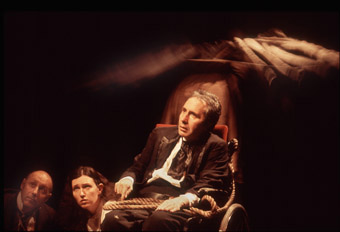Next Wave: The circus deep inside
Mary-Ann Robinson

Nick Papas, Louise Riisik, Ray Drew, Sideshow
photo Ponch Hawkes
Nick Papas, Louise Riisik, Ray Drew, Sideshow
People emerging from trunks to lead the arriving audience through the fringe world of the fairground and vaudeville in a story inspired by Angela Carter’s Nights at the Circus. People do clever tricks. Some walk a dangerous path across chairs that arrive just as their foot descends. There is slapstick-the simple hysteria of funny, round, silly people, battling each other 3 Stooges style. Snatches of circus are cleverly suggested through sound and images. A wild wheelchair does laps at the end of a rope.
All this humour and roughness, sawdust and seductive dancing, is woven together with interludes which have a delicate focus on tiny movements and a touching closeness. And so begins a deep, slow-building exploration of an interior world removed from all that is public.
We are introduced to Bird Woman in this place of sepia tones, romance and uneven beauty. In a drifty dress she itches all over and begins to sprout wings. But is she real, this half-bird, half-woman trapeze artist? Her fans scream, crowding to see her beauty. Her celebrity is assured. She is unsure. A man quietly asks: “Are you real? Do you have a soul? Can you love?”
In such a public world, some become famous celebrities, some are funny, some fall in love. But at any moment the fame, the laughs and romance can crack open to reveal tiny sadnesses, disappointments, uncertainties and rejections.
Sideshow allows us to watch the beauty of the illusion and at the same time the disappointment of knowing it’s not real. Then we see another, more subtle beauty: “I’m sad. I’m not a performer. I won’t come down.” But if you do come down, Valerie, you can show us the simple elegance of a woman in a swirly dress, spinning in soft light, on flat feet, with wings.
Kate Sulan’s direction and the company’s assured ensemble performance make clever use of bold bright circus tricks and sparkling celebrity to point to the truth of that which is absolutely ordinary.
In the end, the trapeze remains empty, a shadow of flight. Instead we are shown something much more remarkable: a man moves without his shell. Using his arms, without his chair, he pulls himself across the stark space of the floor towards a group of standing people. In the shock of this moment it is clear that the things we see in the air are not more extraordinary or beautiful than the things right in front of us—on the ground, as it were.
Rawcus Theatre Company, Sideshow, director Kate Sulan; design Emily Barrie; sound design Jethro Woodward; lighting design Richard Vabre; dramaturg/video Chris Kohn; North Melbourne Art House, May 27-June 4
RealTime issue #62 Aug-Sept 2004 pg. Onl






